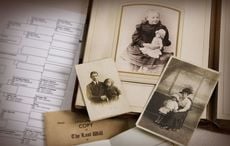Silence and mystery, a form of collective amnesia, surrounded my ancestral history.
When I’d ask Grandma Florence about our family history she’d say, “Let’s sing.”
When I’d ask Grandma Helen she’d say, “Why are you so interested in the dead, young man? Let the dead rest in peace.”
Grandma Helen died before I knew enough to ask, “Do we have any skeletons in our closet, Grandma?”
As I grew older I began to seriously consider my family’s legacy of silence. As I attempted to reconstruct my family's history I realized that my family, like many Irish immigrants, came to America but failed to pass along their stories.
Understandable, I suppose, that many nineteenth-century Irish didn’t speak of the horror that they’d left behind. Who wanted to talk about starvation? “How fast can we forget?” they must have thought. But the silence continued after they arrived, at least in my family. As each new wave of ancestors surged forth, each successive generation washed over the rest, leaving few traces of familial or cultural inheritance. I was confronted with all that had been lost: names and places, buildings and streets, what they saw, how they felt, and their stories; their stories had vanished.
History is replete with stories of the wealthy, but the stories of the poor and dispossessed are rarely recorded. When I began researching one of my ancestral families, the Keatings, poor Irish immigrants who arrived in 1863, I thought it improbable that I’d find any material concerning their lives in newspapers or books. I discovered, however, if the news wasn’t good, it was possible.
Examining microfilm of Brooklyn’s death certificates, I learned that Pierce Keating Sr. died on September 2, 1884.
The cause of death is listed as “Congestion of the lungs following inhalation of smoke at a fire on August 30.” Was Pierce a fireman? Was there a fire at the family’s residence? I uncovered the story of Pierce’s death in a book called “Reminiscences of the Old Fire Laddies and Volunteer Fire Departments of New York and Brooklyn.”
At midnight on Aug. 29, 1884, a fire broke out in a three-story, frame tenement, near the corner of Myrtle Avenue and Raymond Street in Brooklyn, Irishtown, as it was known. A fire company arrived but as firemen entered the home they were driven back by smoke. The firemen extended ladders to the upper floors, but telegraph wires, which crossed the street in front of the burning house, blocked them. Smaller ladders were located and following a critical delay, a rescue attempt proceeded. A fireman entered the apartment and crawling on his hands and knees made his way into the Keating’s apartment. He stumbled across the bodies of Pierce and one of his six children, Daniel, nine years old. The fireman was able to drag the Keatings from the building. Daniel survived; Pierce, age 44, died a few days later.
What else could I learn? I began combing through United States census material and subsequently the Brooklyn Daily Eagle, Brooklyn’s leading daily newspaper from 1841 through 1955. I found three pertinent citations. The first was titled “Pierce Keating’s Death,” which confirmed what I had already learned.
But this article caught my attention:
During the afternoon of September 9, 1885, police raided a house at 41 Raymond Street—a few doors from where Pierce Sr. died a year earlier—and found four women and two men, one of them Pierce’s son, Pierce Keating, Jr., lying on the floor intoxicated. The prisoners were arraigned before Justice Kenna the next morning. Two of the arrested were charged with keeping a “disorderly” house and the other four, including Pierce, were charged with intoxication. According to the news account, Pierce Keating had been convicted a few weeks earlier and was sentenced to the Raymond Street Prison—one block from the family home—for beating an unnamed sister. Although his mother, my great great grandmother Ella Keating, pleaded hard for his release, Justice Kenna sentenced him to nine months in prison. Through some process of law, he was released shortly afterward. For this new charge of “morals,” indiscretion Justice Kenna released Pierce, my great grand uncle, pending appeal.
This article followed on April 30th of the following year:
Young Pierce was in front of Justice Kenna again. Pierce, described as a “medium-sized, well-built young man of 25, with black hair and mustache,” listened as Justice Kenna said, “Here again? I thought we had got rid of you for some time when you were last here.” Justice Kenna signed the complaint: Pierce Keating charged with striking his married sister, Mary Colgan, of 117 Raymond Street, over the head with a frying pan. The article mentions that he had been arrested for assaulting another sister the prior year.
Like many immigrants, the life and times of the Keatings were confined to a very small neighborhood, Irishtown — now Vinegar Hill and portions of other areas, including the Navy Yard and Fort Greene. More specifically, one street: Raymond Street. The neighborhood was populated by poor Irish immigrants who lived in over-crowded, wood-framed houses that were, more often than not, firetraps. Crime and public drunkenness were common occurrences.
The dominant structure on the street was the Raymond Street Jail, Brooklyn’s main prison, which was known as the “Gothic Horror” for its abominable conditions. A week after my great grand uncle Pierce was incarcerated in 1885, the Brooklyn Eagle published an inspection report of the jail. The conditions, by today's standards, were shocking. Seven dungeons or black holes used for the discipline of unruly inmates were all occupied. They were used for inmates who were "quarrelsome" and for those who had attempted to escape.
Hangings were not an uncommon occurrence at the prison. A month before my great-great-grandfather Pierce died in the fire on Raymond Street a hanging was botched. A condemned man’s, gurgling, jerking, slowly swinging death turned a solemn ritual of justice into a horror show. This botched hanging provided the impetus for replacing the preferred method of capitol punishment in the state of New York from hanging to the electric chair.
Brooklyn was not a small town; however, many immigrants’ lives centered on small neighborhoods such as Irishtown. Families like the Keatings struggled with poverty, fire and crime, depravity, despair and early death.
Pierce, Jr. died at the age of 26. This was a short, troubled life, a not uncommon fate for a nineteenth-century Irish immigrant.
Surrounded by the chaos of everyday life, the Keatings struggled to improve their lives, but when they died their voices went with them. In complex and subtle ways, the ties to the past were severed, the bonds broken, and the stories left untold or forgotten. And now it’s left to the descendants of the scorned and silenced to decipher an accumulation of yesterdays, to map their spirits and emotions with words and to return their voices. We are called to bring their stories to life.
---
Charles R. Hale was born, raised and educated in New York. He is a former partner of an NYC based consulting firm Hale, Borenstein Ltd. Charles, along with Niamh Hyland, is a cofounder of Artists Without Walls, an organization purposed to inspire, uplift and unite people and communities of diverse cultures through the pursuit of artistic achievement. His film “Walls: We Are Not Forgotten,” about the life of singer Judy Collins, was presented at the 2012 Eugene O’Neill Award ceremony honoring Ms. Collins. In 2013 the City University of New York honored Charles for ”Outstanding Service to New York and Irish America.”




Comments